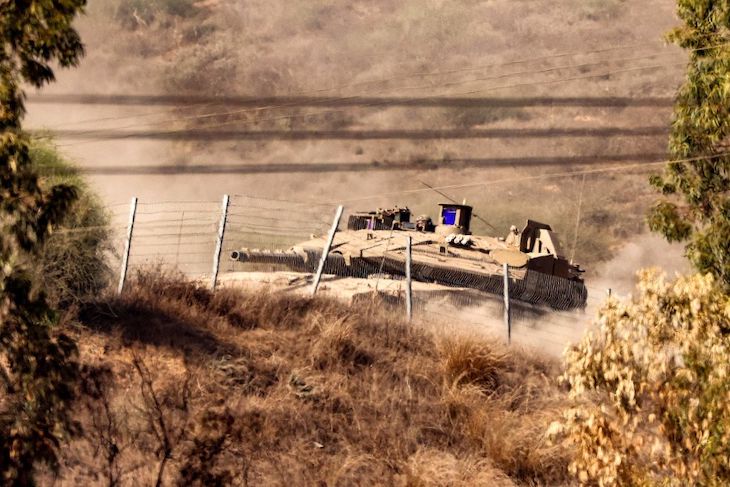As Israel encircles Gaza City, the Israeli Defence Forces (IDF) is conducting what we in the British Army call Fibua, or Fighting In Built-Up Areas. Less ceremoniously, it’s known as Fish – fighting in someone’s house – or Fish and Chips – fighting in someone’s house and causing havoc in people’s streets. But the flippant name belies the danger – and terror – of these operations.
My taste of Fibua came in 2004 during tank operations in Al Amarah in southern Iraq. While my experience might be a little out of date, the fundamentals of urban combat for tanks haven’t really changed. The tank is a formidable weapon. But when you’re inside one you feel anything but assured: it is impossible to see enough and adequately get your bearings when you have the turret hatches closed down. All you have to go on are the letter-box sized periscopes around your commander’s cupola ring, and the constrained image from your gunnery sight. As the RPGs (rocket propelled grenades) and anti-tank weapons thud into the side of your tank, the turret swings around desperately trying to find who is firing. It quickly becomes discombobulating – not least when, in your right earpiece you have the battle group radio network blaring, and in your left earpiece, the other two tank commanders in your troop ranting at you.
Then there is the existential fear of taking a wrong turn; try doing a three-point turn in a 70-tonne tank in a narrow street hemmed in by buildings. As you desperately try to manoeuvre your way out of a tight spot, your tank (and its crew whom you are responsible for) as well as the infantry vehicles you are escorting (and are also responsible for) are sitting ducks for ambush. The mapping in your clammy hands becomes your entire universe, nothing else matters.
Israel’s forces are masters of tank warfare. The IDF honed its skills across the decades during conflicts such as the 1973 Yom Kippur War, against a coalition of Arab military forces led by Egypt and Syria, and repeated wars with Lebanon and Gaza that included significant Fibua.
The capabilities of the latest iterations of the Merkava series of main battle tanks used by the IDF are considered roughly equivalent to that of the British Army’s Challenger 2. Both tanks do a fine job of providing protection, manoeuvrability and firepower, while the Merkava has a few tweaks optimised for urban warfare. It has the ability to carry infantry in its rear, who can dismount through a rear hatch to provide protection against enemy anti-tank measures. It also wields two machine guns – often the most appropriate weapon in close quarters Fibua when the main armament can’t be used.
Israel’s tanks can also call on air support to come to their aid if things turn nasty. The scale of the air campaign against Gaza has illustrated the amount of airborne firepower at Israel’s disposal, while its staunch ally, the US, is no doubt providing further hardware. President Joe Biden has asked Congress to pass a $106 billion (£87 billion) emergency spending package that includes funding for Israel, Ukraine and Taiwan.
At night, things becomes exponentially harder. Ghoulish green shapes appear in your tank’s night vision
In Iraq, the US gave us the services of call sign Basher-75, an AC-130 gunship. ‘You’ve got fire from the sky,’ intoned the impossibly cool voice of the Basher 75 operator over the radio. ‘Keep your heads low, it’s going to get hot down there.’
Boy, did it ever. It was horrible. It was also wonderful. But air support can only go so far once you and your military forces are deeply enmeshed in the urban environment, due to the risk of fratricide and unacceptable civilian casualties.
At night, things becomes exponentially harder. Even streets you are familiar with morph into a different landscape. Ghoulish green shapes appear in your tank’s night vision system with what looks like a rifle in their hands or something on their shoulder. To make matters more challenging for the Israelis, the urban environment in Gaza is obscenely more complex than what we faced in Iraq. Israel’s forces are also up against a far better equipped and trained enemy.
‘Over the past decade Hamas has developed a labyrinth of tunnels that are fortified and connected literally across the entirety of the strip, and especially heavy in Gaza City,’ Rob Givens, a retired US Air Force Brigadier General, writes in Responsible Statecraft.
‘The majority of combat will take place in Gaza City proper which has a greater population density than New York,’ he notes. Civilians ‘are everywhere’ causing the Israelis ‘immense targeting problems’.
I don’t envy the job the Israeli tank commanders have to do.






Comments